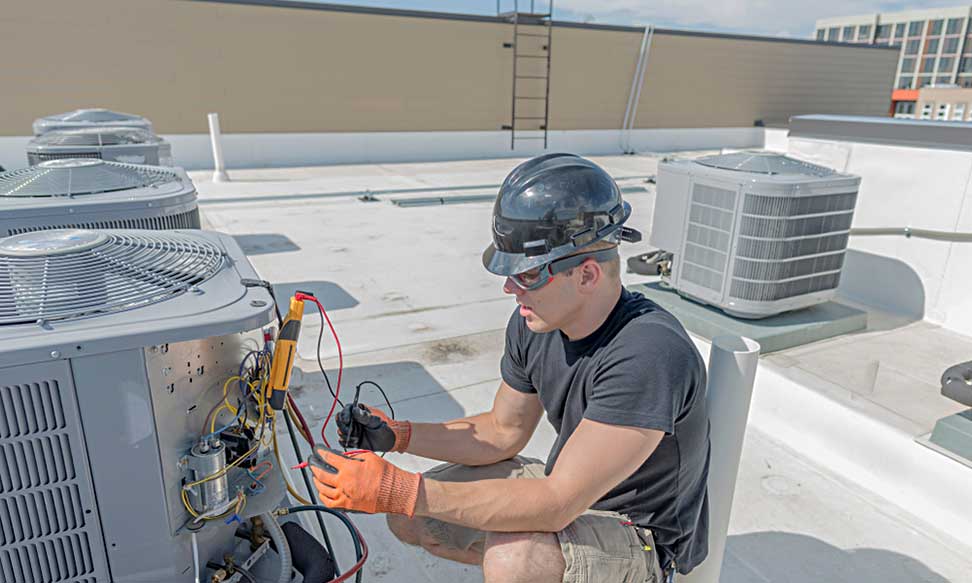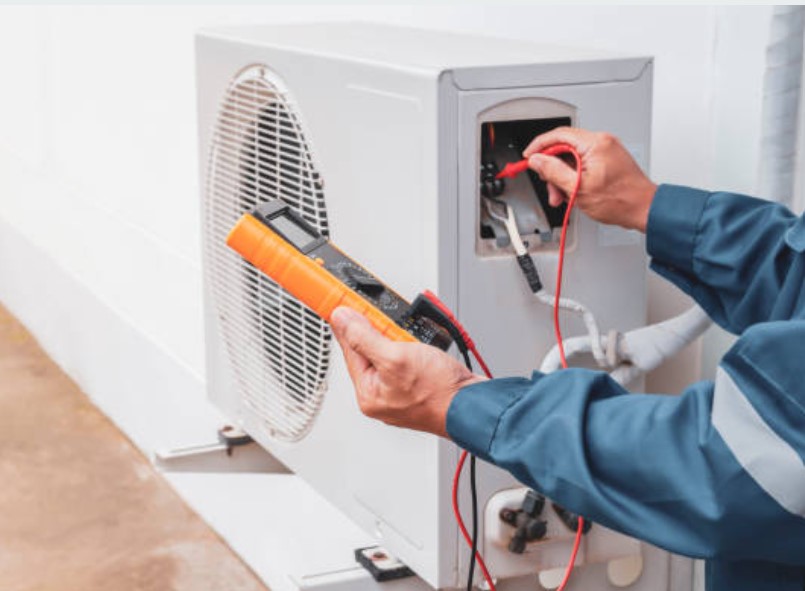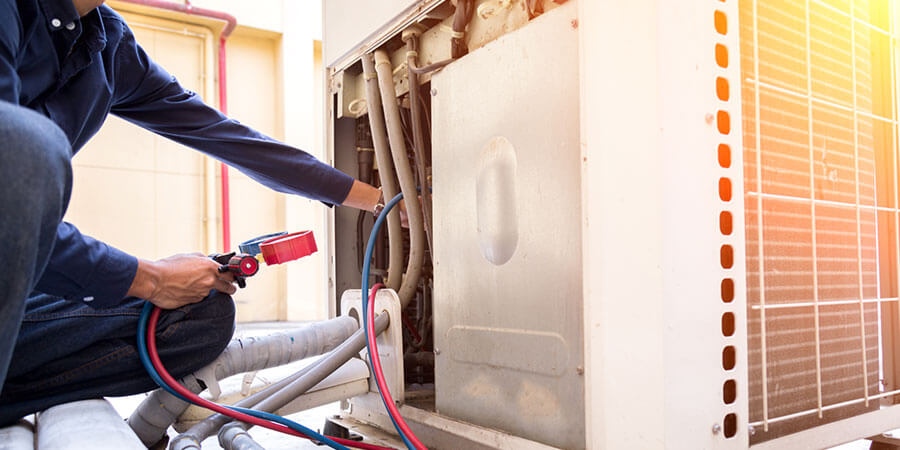What to Expect During a Professional furnace replacement
What to Expect During a Professional furnace replacement
Blog Article
How a Heat Pump and Heater Collaborate to Maximize Your Home's Home heating Effectiveness
Understanding just how a warm pump and heater interact is vital for property owners seeking efficient home heating services. Each system has its strengths, providing a well balanced method to home comfort. The heatpump masters moderate temperature levels, while the furnace supplies fast heat throughout severe cold. This synergy not only minimizes energy prices however likewise enhances the life-span of both devices. What variables influence this partnership, and how can home owners maximize their benefits?
Understanding Heat Pumps: Just How They Function
Although many individuals might be unknown with their inner functions, warm pumps play a necessary duty in contemporary heating systems. These devices run by transferring warmth from one location to one more, utilizing the concepts of thermodynamics. In chillier months, a heatpump removes warmth from the outside air, ground, or water, and transfers it indoors to warm up the home. On the other hand, throughout warmer months, it can turn around the process, serving as an air conditioning system by eliminating warm from inside to the outside.Heat pumps include an evaporator, compressor, growth, and condenser valve. The refrigerant within the system absorbs warm as it evaporates at reduced temperatures and pressures. The compressor after that boosts the stress and temperature level of the refrigerant, enabling it to release heat as it condenses. This reliable process can substantially reduce energy consumption compared to conventional heating methods, making warmth pumps a lasting choice for climate control in homes.
The Duty of Furnaces in Home Home Heating
Heaters play a necessary function in home heating by giving a reputable source of warmth throughout the cooler months. They operate by creating heat via burning or electric resistance, dispersing it throughout the home using ducts or glowing systems. The effectiveness of a heating system is often measured by its Annual Gas Utilization Effectiveness (AFUE) rating, which shows how properly the unit transforms fuel right into heat.Furnaces can utilize numerous energy resources, consisting of gas, electricity, oil, or gas, enabling property owners to select one of the most suitable choice for their demands. Unlike heatpump, which may battle in severe cool, furnaces preserve consistent efficiency, ensuring that indoor temperatures stay comfy no matter outside conditions. In addition, modern heating systems commonly come geared up with sophisticated modern technology, such as variable-speed blowers and clever thermostats, boosting their performance and responsiveness. This versatility makes heaters a critical element in all-encompassing home heating techniques.

Advantages of Using Both Equipments Together
Incorporating the toughness of both heating systems and heat pumps can lead to a much more efficient and effective home heating option. Using both systems allows home owners to capitalize on the heatpump's energy efficiency during milder temperature levels while relying upon the furnace for even more severe cold problems. This dual method can substantially reduce power costs, as heat pumps take in less electrical energy than standard home heating techniques when temperature levels are moderate.Additionally, making use of both systems with each other can enhance convenience degrees in the home. Heatpump can offer consistent, even home heating, while furnaces can quickly raise ambient temperatures when needed. The assimilation of both systems can expand the lifespan of equipment by minimizing wear and tear on each device, as they share the work. Inevitably, property owners can take pleasure in a balanced, cost-effective home heating remedy that changes flawlessly to varying weather problems, making certain a cozy and inviting home throughout the winter season.
Just How Warm Pumps and Furnaces Complement Each Various Other
When house owners integrate heatpump and furnaces, they create a corresponding heater that takes full advantage of efficiency and comfort. Heat pumps run by transferring warmth from the outside air or ground, making them extremely effective in modest environments. They excel throughout milder temperatures, giving cost-efficient home heating. Alternatively, heating systems create warm through combustion or electric resistance, supplying solid, instant heat during extreme cold conditions.The combination of these two systems permits for vibrant adjustments based on temperature changes. During warmer months or milder winter days, the heatpump can take the lead, saving energy and minimizing prices. As temperatures decline, the furnace can seamlessly involve, guaranteeing regular heat throughout the home. This synergy not only enhances energy use but additionally enhances the lifespan of both systems, as each system runs within its perfect performance array. Together, they produce a well balanced setting that adjusts to differing environment needs.
Enhancing Efficiency: Tips for Homeowners
Property owners can boost their home heating effectiveness via several functional methods. Developing a normal upkeep timetable, integrating smart thermostat technology, and carrying out reliable insulation and securing services are crucial actions. These procedures not only enhance convenience however likewise lower power expenses.
Routine Maintenance Set Up
To assure optimal heating performance, establishing a regular upkeep routine is crucial for any home. Homeowners need to focus on routine evaluations of both heatpump and furnaces to ascertain peak performance. This consists of altering air filters each to 3 months, as stopped up filters can substantially minimize efficiency. Furthermore, scheduling specialist upkeep at the very least when a year enables technicians to identify and deal with potential concerns prior to they escalate. Property owners should likewise cleanse the heatpump's exterior device to stop particles accumulation that can hinder airflow. By adhering to a routine upkeep schedule, home owners not just enhance their furnace' performance but also extend their life-span, causing greater convenience and lowered energy expenses throughout the cooler months.
Smart Thermostat Combination
Incorporating a smart thermostat into a home heater can greatly enhance power performance, especially as it enables exact control over temperature level settings. These gadgets can find out the house owner's schedule and preferences, automatically readjusting the temperature level to optimize convenience while reducing power use. They can decrease heating during times when the home is unoccupied, reducing unneeded consumption. Many smart thermostats likewise supply real-time energy use data, allowing house owners to make informed choices about their home heating routines. Furthermore, remote access via smart device applications allows individuals to readjust settings from anywhere, making certain the home is warm upon return. On the whole, smart thermostat integration not just boosts comfort yet considerably adds to energy cost savings and performance.
Insulation and Sealing Solutions
Smart thermostats play an essential function read this post here in power efficiency, yet their efficiency can be greatly improved by appropriate insulation and securing services. House owners should prioritize protecting floors, wall surfaces, and attic rooms to minimize heat loss. Top notch insulation materials, such as spray foam or fiberglass, can considerably boost thermal resistance. In addition, sealing gaps around windows, doors, and air ducts protects against cold air seepage and heat retreat. Weatherstripping and caulking are efficient methods for dealing with these leaks - heat pump service. Routine evaluations for air leakages, together with using blower door examinations, can help identify trouble areas. By buying insulation and securing, homeowners can enhance the performance of their heating unit, eventually resulting in lowered energy intake and reduced energy bills
Usual Myths About Warm Pumps and Furnaces
What false impressions surround warm pumps and heaters? Lots of people erroneously think that warm pumps are inadequate in chillier environments. In fact, contemporary heatpump are developed to operate effectively also in reduced temperature levels, supplying trustworthy heating throughout wintertime. An additional typical myth is that furnaces are constantly much more effective than heatpump. Nevertheless, this relies on the particular power sources and efficiency scores of the devices concerned. Some might additionally think that making use of both systems simultaneously is unneeded, however as a matter of fact, this mix can optimize home heating effectiveness, especially during severe weather. Furthermore, individuals commonly assume that heatpump call for consistent upkeep, when actually, they have similar maintenance requires to standard heating systems. By unmasking these misconceptions, property owners can make more enlightened decisions concerning their heating choices, eventually resulting in enhanced comfort and power performance in their homes.
Upkeep Factors To Consider for Combined Equipments

Regularly Asked Concerns
Can Heat Pumps Work Properly in Exceptionally Cold Climates?
Heatpump can struggle in very cold climates as a result of minimized effectiveness and warmth extraction restrictions. Nevertheless, innovations in technology have actually resulted in versions made for better performance in such conditions, enhancing their practicality in rough atmospheres.
For How Long Do Warmth Pumps and Furnaces Generally Last?
Heatpump usually last 15 to two decades, while heating systems have a lifespan of 15 to three decades. Routine upkeep can extend their longevity, making sure reliable procedure and minimizing the demand for early substitutes.

What Is the Average Price of Putting Up Both Equipments?
The ordinary expense of mounting both a heatpump and a heating system usually varies in between $5,000 to $10,000 - heat pump service. Aspects affecting this cost consist of system size, installation complexity, and regional labor prices
Are There Tax Rewards for Utilizing Energy-Efficient Heating Solutions?
Lots of house owners ask concerning tax rewards for energy-efficient furnace. Different see it here federal and state programs typically use discounts or credit ratings, urging the fostering of sustainable innovations to minimize power usage and promote environmental obligation.
Just how Do I Choose the Right Dimension Warm Pump and Heater?
Choosing the best size heatpump and furnace entails calculating the home's square video, considering insulation top quality, and examining regional environment. Consulting a specialist can ensure suitable system efficiency and energy performance based upon specific demands. heat pump installation ooltewah tn. Understanding exactly how a heat pump and heater work with each other is crucial for home owners looking for effective heating services. In cooler months, a warmth pump extracts warmth from the outside air, ground, or water, and transfers it inside your home to warm up the living area. When homeowners integrate warm pumps and heaters, they develop a complementary home heating system that takes full advantage of efficiency and convenience. Heat pumps operate by transferring heat from the outdoors air or ground, making them highly effective in moderate climates. Heat pumps can have a hard time in extremely chilly climates due to minimized effectiveness and heat extraction constraints
Report this page